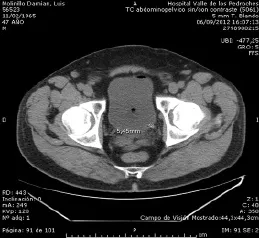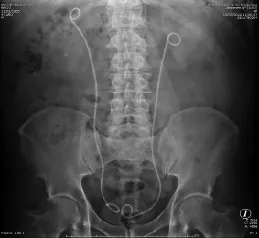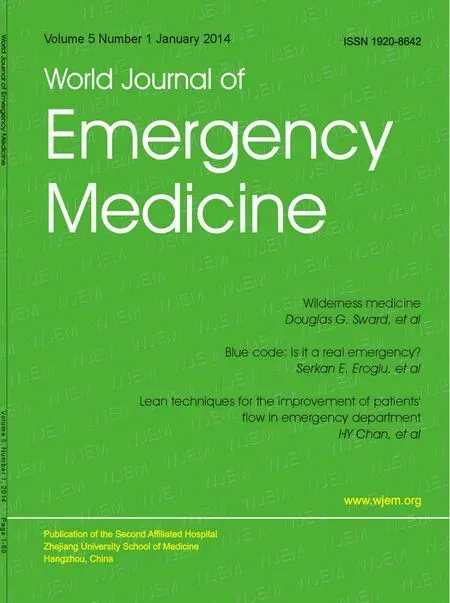Bilateral stones as a cause of acute renal failure in the emergency department
Joaquín V. Alonso, Pedro L. cachinero, Fran R. Ubeda, Daniel J. L. Ruiz, Alfredo Blanco
1Department of Emergency and Critical care Medicine, Hospital Valle de los Pedroches, Pozoblanco, Córdoba, Spain
2Department of Radiology, Hospital Valle de los Pedroches, Pozoblanco, Córdoba, Spain
3Department of Urology, Hospital Valle de los Pedroches, Pozoblanco, Córdoba, Spain
Corresponding Author:Joaquín Valle Alonso, Email: joa51274@hotmail.com
Bilateral stones as a cause of acute renal failure in the emergency department
Joaquín V. Alonso1, Pedro L. cachinero1, Fran R. Ubeda1, Daniel J. L. Ruiz2, Alfredo Blanco3
1Department of Emergency and Critical care Medicine, Hospital Valle de los Pedroches, Pozoblanco, Córdoba, Spain
2Department of Radiology, Hospital Valle de los Pedroches, Pozoblanco, Córdoba, Spain
3Department of Urology, Hospital Valle de los Pedroches, Pozoblanco, Córdoba, Spain
Corresponding Author:Joaquín Valle Alonso, Email: joa51274@hotmail.com
BACKGROUND:Acute renal failure (ARF) due to obstructive uropathy is a urological emergency. The standard radiological investigations in the emergency setting include X-ray, ultrasonography and computed tomography. But occasionally the cause of obstruction may be elusive.
METHODS:We present a case of obstructive uropathy due to bilateral stones presenting as acute renal failure. The patient underwent successful shock wave lithotripsy (SWL) for dissolution of calculi.
RESULTS:The patient was successfully treated, and reported asymptomatic in a follow-up.
CONCLUSION:Close collaboration between nephrological, urological, and radiological services is required.
Bilateral stones; Acute renal failure; Obstructive uropathy
INTRODUCTION
The incidence of a unilateral uterovesicular junction obstruction secondary to a stone is reported at 20% in the literature.[1]Patients may present with the classic symptoms of renal colic and hematuria. Others may be asymptomatic or have atypical symptoms. Possible confirmatory radiologic tests include abdominal plainfilm, intravenous pyelography (IVP), ultrasonography, and most commonly, non-contrasted helical CT scan, which is the test of choice. Urgent urologic consultation is warranted in patients with urosepsis, acute renal failure, anuria, and/ or unyielding pain, nausea, or vomiting. There are few case reports regarding the incidence of bilateral ureteral calculi.[2]Cases of bilateral ureteral calculi are uncommon, and cases resulting in such obstruction are rare.
CASE REPORT
A 47-year-old man with lumbar pain presented to the emergency department. Two days before admission to the emergency department, malaise developed with diffuse lower lumbar pain. His history included smoking 1 pack of cigarettes for 20 years (but not in the past 2 years), diabetes mellitus, hypertension, and hypercolesterolemia. His medications included metformin, losartan, simvastatin and aspirin. He had no recent changes in his medication regimen. He had no family history of vascular disease, hypertension and coronary artery disease and/or stroke. He reported no recent use of nonsteroidal anti-inflammatory drugs or antibiotics. Two months before the admission to the hospital, he had had a sudden, dull pain in the left flank that radiated to the left groin and was associated with mild hematuria. He was evaluated in an emergency department and diagnosed as having renal colic; the pain was relieved after the administration of dexketoprofen, and he was discharged home asymptomatic, no additional analgesic was required. On arrival to the emergency department (ED) he complained of intermittent, mild, bilateralflank pain that was unrelated to physical activity. He reporteddrinking 1 L to 2 L of fluid daily the previous day. His urinary output was diminished and concentrated and in the previous 24 hours the total absence of urine output was recorded. Gross or microscopic hematuria was not present on admission. Physical examination showed acceptable general condition, no fever, and normal blood pressure (125/80 mmHg), heart rate 87 beats per minute, temperature 36.9 °C, costovertebral angles not tender on palpation, etc. Laboratory tests at admission showed glucose 146 mg/dL, GOT 78 IU/L, GPT 45 IU/ L, bilirubin 0.6 mg/dL, LDH 450 U/L, C-reactive protein 46, CK 347 U/L, creatinine 4.5 mg/dL, urea 85 mg/dL, Na 132 mmol/L, K 5.8mmol/L, pH 7.31, and bicarbonate 21 mmol/L. Urinalysis showed a pH of 6.5, urine tested positive (+++) for occult blood; 200 red blood cells; proteins negative; glucose negative; and leukocytes 0. Prothrombin and partial-thromboplastin times were all within normal ranges. The patient was admitted to the observation unit, an indwelling urethral catheter was inserted yielding no urine. Given these findings, the emergency physicians performed a bedside renal ecography showing bilateral moderate hydronephrosis (Figure 1).
The causes of acute renal failure in this patient were considered according to the diagnostic paradigm based on prerenal, intrinsic renal and postrenal factors. The absence of prerenal factors (those that reduce bloodflow to the kidneys) and intrinsic renal disease with a history of physical examination and laboratory studies that rule out shock, rapidly progressive glomerulonephritis, cortical necrosis, and acute tuberal necrosis, as the patient did not have hypotension or inadequate oxygen delivery, systemic symptoms, edema, or any other signs of vasculitis. The patient was afebrile, and microscopy showed no schistocytes, thus ruling out hemolyticuremic syndrome and thrombotic thrombocytopenic purpura. Complete urinary tract outlet obstruction is the most common cause of anuria and should be investigatedfirst as in this patient. According to the hospital protocol, a helical CT of the abdomen and pelvis was performed to show the presence of several stones, three in the right kidney (lower, middle and upper pole), all below 1 cm, one in the right medial ureter of 1.5 cm and other in the left distal ureter, 0.5 cm, the latter producing bilateral moderate hydronephrosis. Furthermore, several simple bilateral renal cysts were presented, empty bladder and prostate of normal size (Figures 2–4)

Figure 1. Bedside ecography showing bilateral moderate hydronephrosis.
Given these results we requested an urgent review by the Department of Urology because of acute renal failure of obstructive etiology (bilateral renal litiasis), proceeding to transfer the patient to the operating room, where two ureteral double-J stents were inserted for urinary tract decompression. A radiograph after the procedure showed the stent in good position (Figure 5). Subsequent urine output was 1 500–2 000 mL on both sides and serum creatinine decreased to a normal range of 0.6 mg/dL. The patient subsequently underwent successful shock wave lithotripsy (SWL) for dissolution of calculi. Stone analysis revealed a predominance of calcium. Serum levels of calcium, phosphorus, calcitriol and parathyroid hormones were all normal, ruling primary hyperparathyroidism as a cause of lithiasis out. The patient has been reported asymptomatic in a followup.
DISCUSSION
Postrenal causes of acute renal failure occur when both urinary outflow tracts are obstructed or when one tract is obstructed in a patient with a single functional kidney. Obstruction is most common due to prostatic hypertrophy, cancer of the prostate or cervix, or retroperitoneal disorders and often presents in the outpatient setting.[1,3,4]A neurogenic bladder can result in functional obstruction. Other less frequent postrenal causes of acute failure can be intraluminal, such as bilateral renal calculi, papillary necrosis, coagulated blood, bladder carcinoma, and fungus, or extraluminal, such as retroperitonealfibrosis, colorectal tumor, and other malignant conditions. Because postrenal causes are readily reversible, it is imperative to exclude them.[5]Rapidly evaluation of the patient in the emergency department demonstrated bilateral renal stones as the cause of acute renal failure.

Figure 2. Left ureteral stone.

Figure 3. Right ureteral stone.

Figure 4. Bilateral renal stones.

Figure 5. Ureteral double-J stents.
Urinary stone disease is commonly seen in 1 of 10 people over a lifetime. Symptoms include severe colicky flank pain. Gross hematuria is present in 15 percent.[6]Others may be asymptomatic or have atypical symptoms such as vague abdominal pain, acute abdominal or flank pain, nausea, urinary urgency or frequency, difficulty in urinating, penile pain, or testicular pain The renal pelvis and ureter contain highly vascular epithelium that, when irritated, can cause bleeding. Blood clots may form and obstruct theflow of urine, which results in pain. Stones may contain either calcium or uric acid. A study by Wang et al[7]conducted between February 2002 and December 2009 showed a prevalence of ARF of 0.72% in a series of 2 073 cases of ureteral stones and onlyfive cases (33.3%, 5/16) were caused by bilateral ureteral stones. The study suggests that risk factors for developing ARF in ureteral stone patients are bigger stones, ureteral stones in patients with only one functioning kidney or pre-existing kidney disease, and bilateral ureteral stones.
Eighty percent of patients with nephrolithiasis form calcium stones, most of which are composed primarily of calcium oxalate or, less often, calcium phosphate.[8,9]The other main types include uric acid, struvite (magnesium ammonium phosphate), and cystine stones. The same patient may have more than one type of stone concurrently (eg, calcium oxalate and uric acid).[9]The risk of nephrolithiasis is influenced by urine composition, which can be affected by certain diseases and patient habits. For calcium oxalate stones, urinary risk factors include hypercalciuria, hyperoxaluria, hypocitraturia, and dietary risk factors such as a low calcium intake, high oxalate intake, high animal protein intake, high sodium intake, or low fluid intake. The diagnosis of nephrolithiasis is initially suspected by the clinical presentation. The best imaging study to confirm the diagnosis of a urinary stone in a patient with acute flank pain is unenhanced, helical CT of the abdomen and pelvis.[10]That can detect both stones and urinary tract obstruction, and has become the gold standard for the radiologic diagnosis of stone disease.[11–13]CT cuts that are 3 to 5 mm in thickness are optimal for the detection of stones. The specificity of helical CT is nearly 100%,[14,15]thus, a positive study confirms the diagnosis of nephrolithiasis and patients should be treated appropriately. Furthermore, a CT scan in patients with a suspected kidney stone candefine an alternate significant diagnosis. Low dose noncontrast CT imaging allows identification of renal and ureteral calculi with similar sensitivity and specificity as standard CT scans but with significantly reduced radiation dosage.[16,17]However, low dose non-contrast CT may be less reliable for detecting small stones (less than 2 mm in diameter). When CT confirms the presence of a stone, a plain abdominal radiograph should be obtained to assess whether the stone is radiopaque. If CT is unavailable, plain abdominal radiography should be performed. Since 75% to 90 % of urinary calculi are radiopaque such as calcium, struvite, and cystine stones, but radiolucent uric acid stones will be missed, small stones or stones overlying bony structures may be missed, and obstruction will not be detected. It is not the imaging modality of choice for initial diagnosis, although it may add to the sensitivity and specificity of an intravenous pyelogram.[18]There is little role for an abdominal plain film when helical CT is available. Although ultrasonography has a high specificity (greater than 90 %), its sensitivity is much lower than that of CT, typically in the range of 11%–24%. Thus, ultrasonography is not used routinely but is appropriate as the initial imaging test when colic occurs during pregnancy.[19]It is sensitive for the diagnosis of urinary tract obstruction and can detect radiolucent stones missed on kidney, ureter and bladder X-ray (KUB); however, ultrasonography may miss small stones and ureteral stones. In the case of bedside renal ultrasound performed by emergency physicians, a recent study demonstrated that there was only a limited impact on the physicians' clinical impression of patients with possible ureterolithiasis and the sensitivity of sonographic hydronephrosis was modest for detecting any ureteral stone, but much better for detecting a large stone.[20]
Urgent intervention is indicated in a patient with an obstructed, infected upper urinary tract, impending renal deterioration, intractable pain or vomiting, anuria, or high-grade obstruction of a solitary or transplanted kidney. Upper tract obstruction increases renal pelvic pressure, which reduces glomerular filtration and renal blood flow. Relief of upper tract obstruction may require either antegrade (percutaneous nephrostomy) or retrograde (cystoscopy and retrograde ureteral catheterisation) approaches. Urethral catheterisation can be performed immediately, but other techniques require planning. Close collaboration between nephrological, urological, and radiological services is required, and in many cases renal replacement therapy may be necessary before relief of obstruction can be achieved. A significant diuresis can complicate relief of complete urinary tract obstruction, through both appropriate (excretion of retained solute and water) and inappropriate mechanisms (tubular concentrating dysfunction). Severe polyuria is rare and requires careful management to prevent volume depletion and possible pre-renal impairment, or overzealous fluid resuscitation and a further drive to dieresis.[21]Obstruction may result in an impaired distal tubular response to aldosterone, resulting in paradoxical hyperkalaemic acidosis when relieved. This usually resolves spontaneously. A small number will have permanent tubular damage and persistent salt wasting nephropathy.[22,23]Approximately 5% of patients with renal stones have concurrent hyperparathyroidism.[24]In addition, most stones in patients with hyperparathyroidism are composed of calcium oxalate.[25]The levels of serum calcium, phosphate, calcitriol, and parathyroid hormone are helpful to diagnose this condition. Primary hyperparathyroidism should be considered in patients with recurrent renal stones especially calcium stones and a high-normal or elevated serum calcium level.
Funding:None.
Ethical approval:The study was approved by the Medical Ethics Committee of Hospital Valle de los Pedroches, Pozoblanco, Córdoba, Spain.
Conflicts of interest:The authors declare that there is no conflict of interest.
Contributors:Alonso JV proposed the study, analyzed the data and wrote thefirst draft. All authors contributed to the design and interpretation of the study and to further drafts.
REFERENCES
1 Hou SH, Bushinsky DA, Wish JB, Cohen JJ, Harrington JT. Hospital acquired renal insufficiency: a prospective study. Am J Med 1983; 74: 243–248.
2 Stone JR, Domanovits H, Kang C. Bilateral obstructing renal stones: an uncommon cause of acute renal failure. Am J Emerg Med 2010; 28: 390.e5–6.
3 Kaufman J, Dhakal M, Patel B, Hamburger R. Communityacquired acute renal failure. Am J Kidney Dis 1991; 17: 191–198.
4 Feest TG, Round A, Hamad S. Incidence of severe acute renal failure in adults: results of a community based study. BMJ 1993; 306: 481–483.
5 Martinez-Maldonado M, Kumjian DA. Acute renal failure due to urinary tract obstruction. Med Clin North Am 1990; 74: 919–932.
6 Grossfeld GD, Litwin MS, Wolf JS Jr, Hricak H, Shuler CL, Agerter DC, et al. Evaluation of asymptomatic microscopic hematuria in adults: the American Urological Association bestpractice policy. II. Patient evaluation, cytology, voided markers, imaging, cystoscopy, nephrology evaluation, and follow-up. Urology 2001; 57: 604–610.
7 Wang SJ, Mu XN, Zhang LY, Liu QY, Jin XB. The incidence and clinical features of acute kidney injury secondary to ureteral calculi. Urol Res 2012; 40: 345–348.
8 Coe FL, Parks JH, Asplin JR. The pathogenesis and treatment of kidney stones. N Engl J Med 1992; 327: 1141.
9 Teichman JM. Clinical practice. Acute renal colic from ureteral calculus. N Engl J Med 2004; 350: 684.
10 Vieweg J, Teh C, Freed K, Leder RA, Smith RH, Nelson RH, et al. Unenhanced helical computerized tomography for the evaluation of patients with acute flank pain. J Urol 1998; 160: 679–684.
11 Pfister SA, Deckart A, Laschke S, Dellas S, Otto U, Buitrago C, et al. Unenhanced helical computed tomography vs intravenous urography in patients with acute flank pain: accuracy and economic impact in a randomized prospective trial. Eur Radiol 2003; 13: 2513.
12 Smith RC, Verga M, McCarthy S, Rosenfield AT. Diagnosis of acute flank pain: value of unenhanced helical CT. Am J Roentgenol 1996; 166: 97.
13 Ulahannan D, Blakeley CJ, Jeyadevan N, Hashemi K. Benefits of CT urography in patients presenting to the emergency department with suspected ureteric colic. Emerg Med J 2008; 25: 569.
14 Dalrymple NC, Verga M, Anderson KR, Bove P, Covey AM, Rosenfield AT, et al. The value of unenhanced helical computerized tomography in the management of acute flank pain. J Urol 1998; 159: 735.
15 Sheafor DH, Hertzberg BS, Freed KS, Carroll BA, Keogan MT, Paulson EK, et al. Nonenhanced helical CT and US in the emergency evaluation of patients with renal colic: prospective comparison. Radiology 2000; 217: 792.
16 Zilberman DE, Tsivian M, Lipkin ME, Ferrandino MN, Frush DP, Paulson EK, et al. Low dose computerized tomography for detection of urolithiasis-its effectiveness in the setting of the urology clinic. J Urol 2011; 185: 910.
17 Jellison FC, Smith JC, Heldt JP, Spengler NM, Nicolay LI, Ruckle HC, et al. Effect of low dose radiation computerized tomography protocols on distal ureteral calculus detection. J Urol 2009; 182: 2762.
18 Elton TJ, Roth CS, Berquist TH, Silverstein MD. A clinical prediction rule for the diagnosis of ureteral calculi in emergency departments. J Gen Intern Med 1993; 8: 57.
19 Shokeir AA, Mahran MR, Abdulmaaboud M. Renal colic in pregnant women: role of renal resistive index. Urology 2000; 55: 344–347.
20 Moak JH, Lyons MS, Lindsell CJ. Bedside renal ultrasound in the evaluation of suspected ureterolithiasis. Am J Emerg Med 2012; 30: 218–221.
21 Harris KPG. Urinary tract obstruction. In: Johnson RJ, Feehally J, eds. Comprehensive clinical nephrology. 2nd ed. London: Mosby, 2003: 745–758.
22 Lameire N, Van Biesen W, Vanholder R. Acute renal failure. Lancet 2005; 365: 417–430.
23 Xing XZ, Wang HJ, Huang CL, Yang QH, Qu SN, Zhang H, et al. Two acute kidney injury risk scores for critically ill cancer patients undergoing non-cardiac surgery. World J Emerg Med 2012; 3: 278–281.
24 Rutchik SD, Resnick MI. Ureteropelvic junction obstruction and renal calculi: pathophysiology and implications for management. Urol Clin North Am 1998; 25: 317–321.
25 Manthey DE, Teichman J. Nephrolithiasis. Emer Med Clin N Am 2001; 19: 633–654.
Received March 28, 2013
Accepted after revision September 25, 2013
World J Emerg Med 2014;5(1):67–71
10.5847/ wjem.j.issn.1920–8642.2014.01.012
 World journal of emergency medicine2014年1期
World journal of emergency medicine2014年1期
- World journal of emergency medicine的其它文章
- Instructions for Authors
- Blue code: Is it a real emergency?
- Presepsin as a novel sepsis biomarker
- Acute temporal lobe infarction in a young patient associated with marijuana abuse: An unusual cause of stroke
- Prehospital difficult airway management: old things still work
- Flashback phenomenon and residual neurological deficits after the use of "bath salt" 3, 4-methylenedioxypyrovalerone
